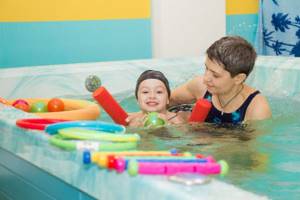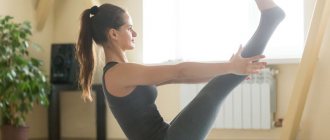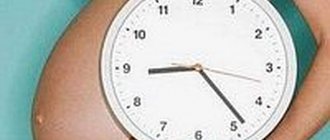Swimming is one of the earliest sports that has virtually no contraindications. The section accepts children from 3 years old. Swimming for children can be both sporting and recreational.
Its benefits are due to the combination of physical activity and the healing properties of water. Little-known facts about the benefits of swimming for children.
What are the benefits of swimming for children?
Much has been said about the benefits of swimming for children, but in addition to well-known truths, such as harmonious physical development and strengthening the nervous system, this sport also has a number of positive qualities that parents need to know about, namely:
- Improvement of cognitive functions. Early exercise in water stimulates the areas of the brain responsible for cognitive functions. According to research results, children who participated in the pool from three to five years old are significantly ahead of their peers in reading, literacy and mathematics;
- Reducing the risk of accidents on the water. By exercising in the pool, your child will not encounter a water accident in the future. Here he will be taught how to behave correctly in extreme situations in order to get to the shore and not drown, because, as we know, the most common cause of drowning is panic;
- Developing independence and determination. Swimming, like any sport, makes children courageous, purposeful and independent. These qualities will allow them to achieve great success in the future, and this applies not only to sports, but also to their career and personal life. According to statistics, swimmers most often become successful businessmen and scientists.
In general, swimming can be called the most useful sport, especially for preschool children. Regular classes will help strengthen all body systems, which will have a positive effect on the child’s further education in primary school.
Previous swimming training
If the child is too young, he or she will not learn to swim right away. But swimming for babies gives them the opportunity to relax and fall in love with the water. Such children will then learn to swim more easily and quickly.
Medical research says that swimming has a positive effect on all vital systems of the human body. Muscles, respiratory and support systems develop equally. The blood is saturated with oxygen, the functioning of the central nervous system improves.

Men's swimming
Early learning activities provide excellent health benefits. A program is being developed for this purpose. The program includes a plan with specific exercises. Thanks to this, the baby will quickly master this pleasant science.
Important. If you decide to visit a swimming pool, you should strictly follow safety precautions.
When choosing a pool, you should pay attention to the availability of a qualified instructor, the safety of the building and the pool itself. The method of cleaning the pool and treating the water is important. There should not be too many harmful substances in the water!
Types of swimming
Competitive swimming includes several disciplines. At first, children engage in general swimming, but later they need to choose a direction for further development.
The sections teach the following disciplines:
- Crawl. This is the fastest type of movement in water. Front crawl is also called free style. The crawl also happens on the back. This discipline is considered one of the most dynamic and spectacular in competitions. To practice crawling, you need such data as endurance, physical strength and reaction speed;
- Breaststroke. This type is the most silent, which is why it was used during hostilities. Breaststroke swimmers must have strong arms, because the arms are the main tool for moving through the water in this discipline. The main difficulty of breaststroke is considered to be mastering breathing, because you cannot swim with your head raised above the water;
- Butterfly. Most often, butterfly is perceived as a type of breaststroke, but this is a mistaken opinion. This discipline is characterized by high speeds and serious physical exertion. This type takes on guys with good physical characteristics and impressive muscle mass;
- Synchronized swimming. This discipline is significantly different from others, because it is a dance in water, which requires serious endurance and endurance from athletes. This discipline is considered a women's sport. Girls should have a sense of rhythm and flexibility. Girls from the gymnastics section often come here.
There are other types of swimming, but they are not included in the competition program and are considered amateur. These include frog, Georgian and doggy styles.
Pros of swimming:
- Maximum inclusion and training of the entire musculoskeletal system (musculoskeletal system). Swimming provides a universal and maximum load for the development of all muscle groups; the following are developed effectively: the shoulder girdle, arms, legs, body muscles, abdominal and back press, and others. This is very important for a child’s growing body.
- The pulling effect accelerates the child's growth. As you know, a child grows faster in water. Body weight in water is much less, the compression load on the spine and joints is completely removed, and the spine and all limbs are greatly stretched during swimming, which accelerates growth and at the same time moderately pumps and strengthens muscles. This is an ideal combination for a growing organism. And if gymnastics or acrobatics reduces a child’s growth, swimming, on the contrary, contributes to it.
- Swimming perfectly develops the initial coordination of the whole body necessary for life. It is known that coordination develops and trains as a person grows up; in children it will be worse than in adults, although it happens differently :) Swimming and, in general, mastering coordinated movements in water, as in a special environment, develops the correct sensation of the whole body , coordination and ability to control oneself (your body). Further, of course, other types of art and sports (martial arts, dancing, etc.) will not interfere with the development of coordination.
- Mastering proper deep breathing. Many diseases appear in adulthood due to the fact that a person has become accustomed to breathing incorrectly since childhood and his lungs are never fully pumped, ventilated, and therefore not cleaned. It is well known that swimmers have a well-developed shoulder girdle and chest, large and open lungs, thanks to this, swimmers are healthy, energetic people and they practically do not have diseases associated with the lungs (asthma, etc.).
- Natural hardening, healing and strengthening the child’s immunity. Water has unique healing properties, our ancestors knew about this 1000 years ago. Water heals and strengthens. Year-round swimming lessons will help harden your child and strengthen the immune system, which protects him from various types of viral and other diseases.
- Emotional charge and discharge. It is very important for a child that he gives his all during training, discharges himself emotionally and at the same time without physical overload. Swimming provides just such stress. If a child comes out after training without realizing himself, without throwing out his energy, this is not very good; such training will not give the child complete satisfaction and the best result. After a good swimming training, the child should come out satisfied, emotionally calm (pleasant fatigue), and there should be a feeling that he gave his best during the training. Only such training will give qualitative growth, and if the child is not even tired, at least a little, this is not training, but maximum entertainment.
- Removing negativity, tension, irritation and the healing properties of water. Children are different, sometimes they are calm and positive-minded, but it also happens that a child comes to training with negative emotions, in a state of irritation or emotional distress. So, water has unique calming properties that remove negative energy. Water washes away negative charges, removes emotional and physical stress, relaxes and calms. After swimming lessons, as a rule, children come out positive and calm, without negative emotions. Therefore, I especially recommend swimming for children who are not calm and emotional.
- Intensifying other workouts. Swimming and water activities enhance the effect and results of training in other sports. Swimming is recommended to be added as an additional type of exercise. Exercises in water quickly restore muscles, relax and remove soreness (consequences of physical overload), increase endurance, breathing and overall strength of athletes. It is advisable to enroll your child in competitive swimming no earlier than 5 years of age.
At what age should a child start swimming?
For health purposes, it is recommended to send children swimming in infancy. In such sections, mothers visit the pool with their children, and children from 3 years old are recruited for classes. At such a young age, group classes are also recreational in nature and prepare the baby for a future sports career.
Children begin to study professionally at the age of 7. At this time, schoolchildren have already decided on the main direction and begin to prepare for competitions and performances. When registering a young athlete in a professional section, it is necessary to take out insurance for the child. The cost of insurance depends on the insurance period and completeness of coverage.
Swimming lessons in the pool for children
Swimming lessons in the pool for children can be divided into recreational and sports. Even if you have enrolled your child in the section, for the first year he will engage in recreational swimming. This is necessary to build muscle mass, familiarize yourself with the technique and adapt the body to frequent exposure to water.
When exercising in a swimming pool, the following side effects may occur due to the high chlorine content:
- Skin rashes and peeling;
- Inflammatory diseases of the respiratory tract.
If after exercising in the pool you notice these manifestations in your child, consult a doctor; you may need to change the pool or choose a different sport for him.
Swimming is beneficial
Regular visits to the pool can solve many health issues, and for those who cannot swim, learn.
Strengthening muscles. Swimming has a positive effect on the human body and is a good substitute for any sport. If when playing sports a certain group of muscles is trained, then during swimming all muscles are involved. In this case, there is no strong load on the muscles; during movements, one group of muscles tenses, while the other relaxes, and so on in turn.
In water, a person actively uses his legs, which has a positive effect on reducing the volume of the hips and also strengthens the leg muscles.
When swimming, the biceps, triceps, shoulder deltoid muscles, finger flexors, neck muscles, pectoral muscles, serratus anterior muscles, latissimus muscles and so on work - that is, the whole body is involved in the work.
However, the load on different muscle groups is different, it all depends on what style of swimming you use. For example, during breaststroke, the main load falls on the large round muscles of the back. When butterflying, the muscles of the legs develop, namely: the muscles of the pelvic girdle, the muscles of the thigh, the muscles of the lower leg and the muscles of the foot, as well as the arms.
During swimming, an invisible corset is created, which secures the spine in a straight position, which makes it possible to form a beautiful posture. Due to the fact that the water smoothly flows around the body, a slender figure with toned muscles is created.
During swimming, there is no high load on the joints, so exercising in the pool allows you to improve the functioning of the musculoskeletal system and quickly recover from serious injuries.
The cardiovascular system also finds itself in a positive environment for its functioning. The horizontal position in which a person is in the pool allows the heart to pass blood through the arterial system to the periphery horizontally. This makes her work easier than when a person is in an upright position. Exercising in the pool improves blood circulation, optimizes heart rate and normalizes blood pressure. People who often swim do not complain about the functioning of the cardiovascular system and are less prone to developing a heart attack and other diseases of the heart and blood vessels.
The respiratory system also benefits from swimming in the pool. During exercise, a person takes a full breath thanks to the water pressure and exhales. As a result, such breathing exercises help strengthen the lungs, train the bronchi and alveoli, increase the elasticity of the lungs, increase the size of the chest and the vital capacity of the lungs. People who frequently exercise in the pool do not experience shortness of breath while walking or climbing stairs.
Regular exercise in the pool strengthens the immune system . This means that the body will easily tolerate changes in the external environment and be less susceptible to viral infections in the winter.
Swimming develops endurance in both children and adults. In the first lessons, the distance is not large and is covered over a long period of time. Each time the distance increases, and the time to overcome it decreases. In this way, endurance is developed and a person is not afraid to climb mountains, go jogging, or cover long routes on foot.
For those who want to lose excess weight , you should know that exercising in the pool is equivalent to running or aerobics. In two hours of swimming in the pool you can burn up to 2 kg of fat. Today you can find groups recruiting for water aerobics. Training takes place together with a trainer and the classes give tangible results.
Watch the video below to learn how to swim properly to lose weight.
In order for swimming to be beneficial, you need to swim correctly. For information about the features of swimming with back diseases, watch the video below.
It is also worth remembering that water calms a person. This means that swimming in the pool has a positive effect on the nervous system, brings it back to normal and helps relieve irritability and fatigue.
Swimming in the pool disciplines, develops perseverance, endurance, determination, helps to cope with stressful situations and strengthens a person.
That’s why it’s worth going to the pool and swimming for both adults and children. If you come with the whole family, the time will not only be useful, but also fun.
Watch a video about the benefits of swimming.
Methods of teaching children to swim
The method of teaching children to swim depends on the purpose of the lesson. If this is a health section, classes are held 2-3 times a week. Children learn how to float on the water, perform various exercises and learn techniques.
If the goal of the classes is big-time sports, the teaching methodology is aimed not only at lessons in the pool, but also at strengthening the muscle corset and increasing endurance. In this case, training takes place every day. Classes in the pool are followed by workouts in the gym and on the treadmill. Children also take a dry swimming course.
Recreational swimming for preschoolers
This option is suitable for parents who want to improve their child’s immunity and health. The baby will have to start learning, and swimming will prevent the occurrence of flat feet and scoliosis. It will also help make the spine more flexible. Regular exercise improves heart function and maintains the sports spirit. Thanks to this activity, the baby is provided with healthy sleep.
If there is a garden in the immediate area with a swimming pool, this is an ideal option. The maximum number of children in a group is 10 people.
But, if the preschool educational institution is not equipped with a swimming pool, you can visit any sports complex.
Swimming accessories for children
If you decide to send your child swimming at an early age, you need to purchase swimming accessories for children that will keep your baby as safe as possible. Without these accessories, your child will not be allowed to attend classes.
You will need to buy:
- Hats. You will need to buy a silicone swimming cap and a cotton cap, which you put on after a shower until your hair is completely dry;
- Glasses. The color of glasses should be chosen according to the lighting. In open water and in pools with strong lighting, dark lenses are suitable, blue and gray are for reducing brightness, orange and brown are for dim pools;
- Earplugs. Pool earplugs are reusable and disposable. Until your little one learns to care for her accessories, it is better to buy disposable pads;
- Oversleeves. Armbands for children are selected according to size. It is important to choose an accessory so that it does not come off your forearm and does not pinch your hand;
- Swimming belt. The smallest swimmers need a belt. This accessory is used only at the stage of teaching a child to float on the water. The belt is selected according to the baby’s weight;
- Swimsuit or swimming trunks (2 pcs.). Girls need to buy one-piece swimsuits, and boys should buy swimming trunks in the form of shorts.
A complete set of accessories costs an average of 3,000 rubles. Also make sure to buy two towels, a washcloth and soap, pool shoes and a comfortable bag. Before enrolling in the section, you will need to undergo a medical examination to exclude contraindications to classes.
Useful information about swimming
Tips for parents:
- Before starting training, go to an appointment with a pediatrician and make sure that your child has no contraindications to training in the pool:
- kidney disease;
- heart failure or heart defects;
- convulsions;
- allergies;
- joint diseases;
- and etc.
- After classes, be sure to work on your baby’s ears for a while with ear sticks to remove any water that has gotten into them.
- Take the child out of the center building with a dry head and in thick clothing.
- Don’t be afraid of your child’s cold at the initial stage of training - the child is hardened and his immunity increases.
- If a child attends classes without enthusiasm, find out the reason and try to change the coach or the pool itself; Perhaps the child does not have enough friends in classes, you can agree with the parents of familiar children about joint training.
- If your baby gets overexcited at every lesson, cries, screams and otherwise expresses anxiety, it is better to suspend the lessons or simply postpone them for several months or years. After a while, you should invite the child to go to the pool again.
Medical contraindications
Swimming as a sport has a number of contraindications for which exercise in the pool is strictly prohibited, these include:
- Any skin diseases, including dermatitis, scabies, eczema, psoriasis;
- Diseases and injuries of the spine (except for spinal curvature);
- Congenital and acquired heart disease;
- Chronic and acute viral diseases;
- Epilepsy and other disorders of the nervous system with the manifestation of convulsive syndrome.
Also contraindications include a panicky fear of water. If your child is terribly afraid of water, there is no need to force him to study, this will not solve the problem and will only worsen the psychological problem.









